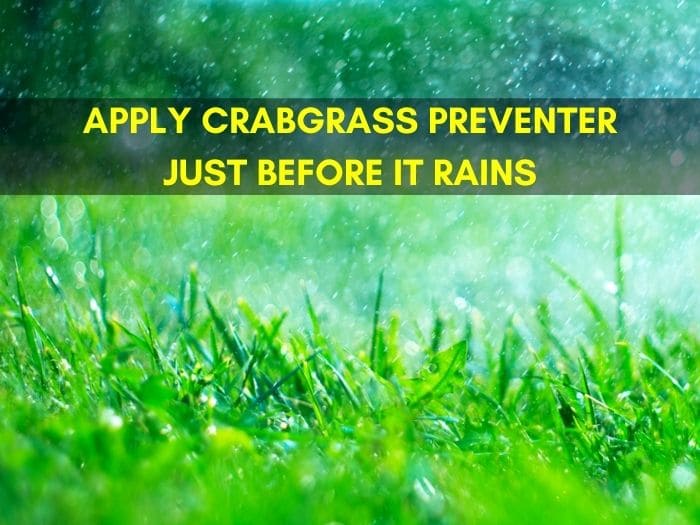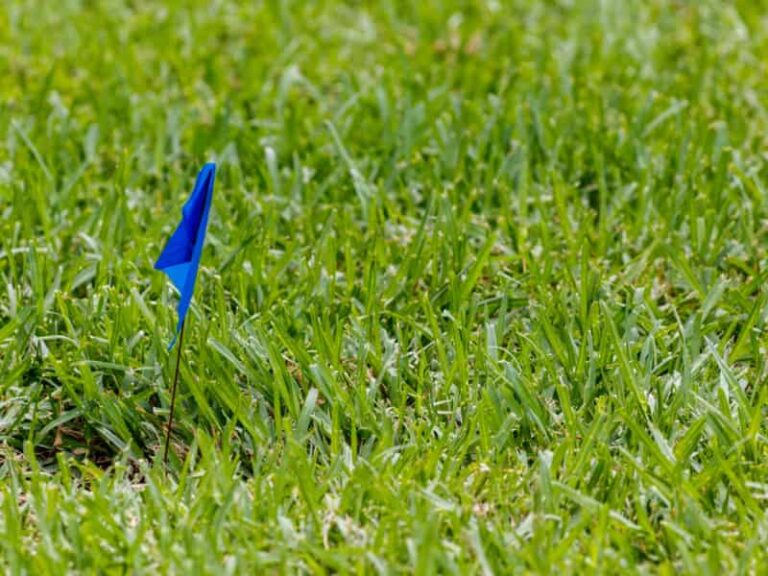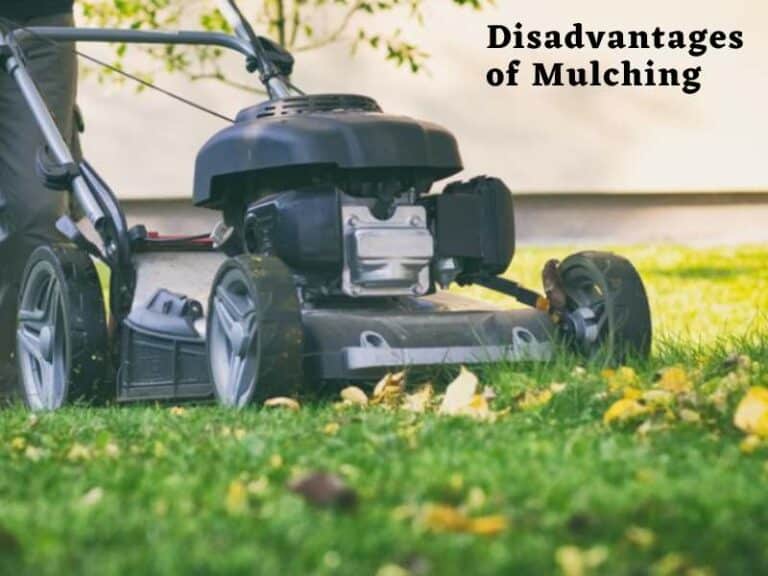When to Apply Crabgrass Preventer [Before or After Rain?]
Crabgrass (Digitaria sanguinalis) is a stubborn invasive grassy weed that keeps a low profile and dodges mower blades when mowing lawns. It’s coarse and has light-green clumps with a sprawling stem that looks like crab-producing seeds at the end of the year lifecycle. Crabgrass can be controlled successfully with a good pre-emergent herbicide put down at the right time. When temperatures start to warm up in spring, crabgrass seeds start to germinate. So, when should you apply a crabgrass preventer to your lawn?
Apply crabgrass preventer in early spring when soil temperatures start to warm up to 55 °F. It is best to apply pre-emergent just before it rains so that the herbicide is washed down into the soil. Dogwood and forsythia blooms are a good sign to start applying crabgrass preventer.
A great pre-emergent to apply is Scotts Crabgrass Preventer if you want to control the weed all season long. In the fall, temperatures start to drop, and a pre-emergent will not be effective on crabgrass.
Keep in mind that a crabgrass pre-emergent herbicide does not stop the weed from germinating. All it does is inhibit crabgrass root growth, allowing your grass to out-grow and kill the weeds. This is why pre-emergent timing is really important here.
When to apply crabgrass preventer

Apply crabgrass preventer in early spring when the sun starts to come out. The timing should be when the soil temperature is between 55 °F and 70°F when crabgrass seeds become activated by the warmth to germinate. Put down the pre-emergent when it is forecast to rain in a few hours to ensure the herbicide is washed down into the soil for weed germination.
Here’s a quick guide on the timing:
| Soil temperature | Apply crabgrass preventer when the soil temperature is 55 °F and 70°F. |
| Before or after rain? | Apply a few hours before it starts to rain. |
| Environmental sign | Time when forsythia and dogwoods start to bloom. |
| Mowing | Apply after at least the first 2 mowings of the season. |
Signs the Timing is Right for Putting Down Pre-emergent
Sometimes we are not sure whether our timing is right. The onset of spring can be quite vague, leaving you confused and not knowing when to put down your pre-emergent.
Here are a few signs to help you with the timing for crabgrass preventer:
1. Soil temperature rising above 55 °F
When winter ends and spring kicks in, temperatures start to rise. This is when crabgrass and other weeds become active and start germinating.
If you start taking soil temperatures, you might want to be on the lookout for 55 °F. When the soil becomes this warm, crabgrass seeds will start germinating.
It is advisable to put down crabgrass preventer when the soil temperature is at least 55°F or more at a depth of 1 – 2 inches for 3 days straight. In fact, crabgrass seeds will start to germinate when the soil temperature is between 60°F and 70°F.
- Moisture, wind, and sunlight can affect soil temperature in your lawn.
- Soil temperature in a shady lawn can vary compared to areas that receive full sunlight.
You might want to consider these two factors when measuring the temperature of your lawn.
Therefore, you might want to start taking soil temperatures in your lawn in early spring (and in the right spots) to be sure of the right time to put down the pre-emergent herbicide. You’ll need a reliable soil thermometer for this.
2. Dogwoods and forsythia blooms
Forsythia bushes start to bloom from mid-March to mid-April. This is when temperatures start to rise to signal the onset of spring after a long cold winter. If you see the cascade of bright yellow forsythia flowers, it is a sign that you can put down crabgrass preventer herbicide to stop the germination of weeds.
If you don’t have forsythia bushes in your neighborhood, you can rely on dogwood for your timing.
Dogwoods produce fragrant white flowers, usually blooming from late March to mid-May. When you see these flowers, it is still a good time to put down your pre-emergent herbicide to stop crabgrass from germinating in your lawn.
3. Late February – early April
Another great indicator you might want to look out for when the timing to put down crabgrass pre-emergent is the spring calendar. Since spring does not start the same day each year, a seasonal calendar will help determine the best time to apply a crabgrass pre-emergent herbicide.
For example, in 2021, spring is set to begin on Saturday, March 20. This is a good time to work on your lawn and put down herbicides that prevent early weeds – both broadleaf and grassy lawn weeds.
Pro tip: If you apply the crabgrass preventer too early, it can break down or weaken, leaving it ineffective at preventing the germination of crabgrass and other stubborn weeds.
Applying pre-emergent before or after rain

Apply crabgrass preventer just before it rains so that the rainwater can wash down the herbicide into the soil and get into contact with crabgrass seeds. When the weather forecast predicts rain in a few hours in early spring, it is the right time to start applying the pre-emergent.
If, for some reason, it does not rain, water the lawn immediately or 2 to 3 days after putting down the pre-emergent to make sure it is washed down into the soil to stop crabgrass from germinating. Follow the product’s label when irrigating the lawn if it does not rain after herbicide application.
Note: Heavy rain can wash away the herbicide; therefore, you may need to repeat the applications one or two more times to ensure proper coverage and prevention of crabgrass.
Can you apply on a wet lawn?
You can apply liquid crabgrass preventers on wet grass because the liquid concentrate will wash down into the soil and stop weeds from germinating. However, applying granular crabgrass preventers on wet turf is not a good idea because the herbicide will just stick to the wet leaves and have no effect on controlling weeds.
In case you put down the herbicide when grass blades are still wet, water the lawn adequately to wash the pre-emergent off the leaf blades and into the soil.
When should I apply Scotts Crabgrass Preventer?
Scotts Halts recommends that you apply the pre-emergent herbicide early in spring to control the germination of crabgrass, poa annua, chickweed, and other lawn weeds before germinating in your yard. You should also apply a crabgrass preventer before the 3rd and 4th mowing of the season for prolonged control of weeds in your lawn.
If you’re not sure, any time during the onset of spring – late February to April – will still be okay to put down Scotts Crabgrass Preventer.
Scotts Crabgrass Preventer contains lawn food, meaning it will nourish your new lawn and reduce the need for fertilizer applications. Keep in mind that the fertilizer analysis on this herbicide with lawn food is 30-0-4, so there’s plenty of nitrogen to help your lawn spread quickly and grow thicker.
Caution: Do not apply Scotts Crabgrass Preventer on lawns established with bentgrass and dichondra because it has the ability to prevent these turfgrass types from germinating.
Is it too late to put down crabgrass preventer?
It is too late to apply a preventer when crabgrass has already germinated in your lawn. A pre-emergent herbicide is meant to inhibit germinating crabgrass seeds from developing roots. If you see young shoots of this weed in your lawn already, you’ll need to apply a post-emergent crabgrass killer instead to control the grassy weed.
Also, when soil temperatures start to drop at the tail end of spring, it is already too late to apply crabgrass pre-emergent because the next round of germination for the grassy weed will come in spring when temperatures start to rise again.
Do you water after applying crabgrass preventer?
Yes, watering down pre-emergent is a great practice because it ensures the herbicide seeps into the soil to get in contact with crabgrass seeds. Always water your lawn after applying solid pre-emergent herbicides on wet or dry grass blades.
The only time you might not want to water your lawn is when using a liquid crabgrass preventer because the concentrate will wash down into the soil by itself for action against weeds in the soil.
Seeding after Putting Down Crabgrass Preventer
How long after putting down the crabgrass preventer can I seed? It’s important to take at least 2 weeks to 6 months after putting down a crabgrass preventer before seeding your lawn. This should, however, depend on the herbicide you used.
There are two types of crabgrass preventers:
- Short residual pre-emergent: This type of herbicide will remain potent for up to 60 days post-application. It is best to seed your lawn after waiting out this period. Apply the herbicide at the onset of spring.
- Long residual crabgrass preventers: Long-term crabgrass preventers stop crabgrass all season long. Apply only on already established lawns to control crabgrass.
Dimension 2EW Herbicide is a water-based herbicide that provides long-term crabgrass control, while the Team and Scotts Halts are examples of short-term pre-emergents.
Pro tip: Seeding too soon after putting down crabgrass preventers can cause poor and uneven germination of grass seeds. In fact, some brands can inhibit the growth of grass seeds at a high rate.
For example, Scotts Halts Crabgrass Preventer will stop bentgrass from germinating. Avoid using it as a pre-emergent when you want to seed your lawn with this creeping bentgrass and dichondra.
Can you apply crabgrass preventer in fall?
Temperatures start to drop in fall so crabgrass seeds won’t be germinating during this time. There’s no need to apply a crabgrass preventer in fall. The low temperatures and frost will kill crabgrass and leave bare spots that’ll need overseeding to fill them up.
Sources + References
- Kevin Frank, Michigan State University, Department of Plant, Soil and Microbial Sciences – Timing crabgrass preemergence applications in an early spring
- Dr. Leonard Perry, Extension Professor, University of Vermont, Department of Plant and Soil Science: Crabgrass Control
- University of California Agriculture and Natural Resources: Crabgrass Management Guidelines
- Mathew Elmore and Daniel P. Tuck, RUTGERS New Jersy Agricultural Experiment Station: Crabgrass Control in Lawns for Homeowners in the Northern US
- University of Missouri Integrated Pest Management: Spring Lawn Care – Aeration, Fertility and Crabgrass Control


![Killing Crabgrass With Baking Soda [Homemade Killer With Pictures]](https://lawnmodel.com/wp-content/uploads/2020/11/Baking-soda-crabgrass-killer-homemade-768x546.jpg)

